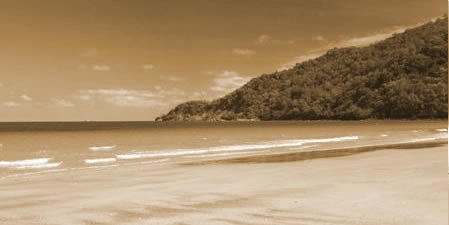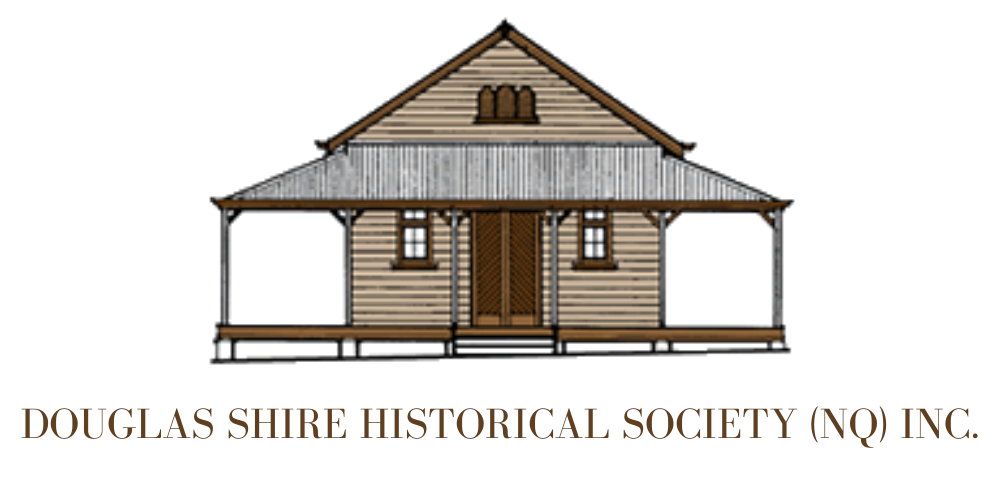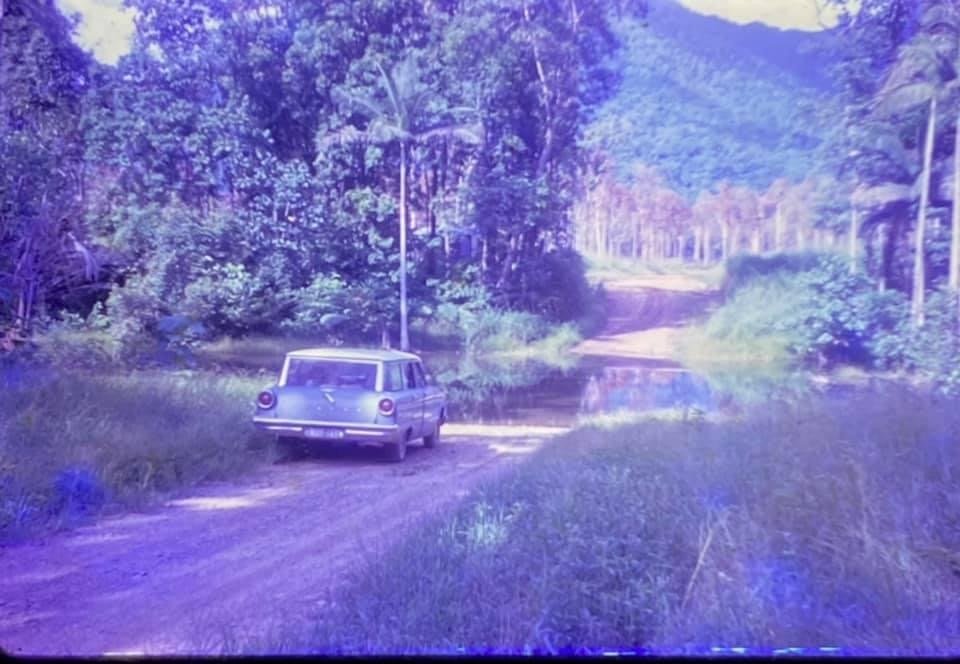Cow Bay | Bailey’s Creek | Diwan
The original settlement of Bailey’s Creek is now called Cow Bay. Some say it was named after wild cattle, probably left from John Moffat’s settlement, that were seen grazing near the beach. The possibility is that it was named for the sea cows, or dugongs although the beach is not known for them.
The Aboriginal name for Cow Bay is Yirrkiji (pronounced yid-ki-gee). It is the traditional land of the Kuku Yalanji people.
There are several theories about who Bailey’s Creek was named for.
There is no town called Cow Bay. The Cow Bay Hotel is on the main road.
Diwan, its aboriginal name means Scrub Turkey, is the nearby local administrative area on the other side of the main road, with a petrol station with shop and mail drop off, sports facilities and medical centre. There is also a home-made ice-cream store, a tea plantation, and guided tour companies.
The area is home to the Musky Rat Kangaroo, the smallest of the kangaroo family with the shortest mammal gestation of just 12 days. These are found nowhere else in the world.
The rainforest-clad Thornton Peak dominates the region behind Diwan. Alexandra Bay, Thornton and Noah beaches and Cooper Creek are other local features.
Cow Bay has a colourful past of farming, logging and grazing. Today tourism is the main industry and sustainability is a principal aim of the local community.

1770
Lieut. James Cook wrote in his journal: ‘close under the Main land is another Island, [Snapper Island] Tolerable high, which bore from us at Noon distant 7 or 8 Miles’.
1815
Lieut. Charles Jeffreys (or Jeffries) of His Majesty’s armed brig Kangaroo named Snapper Island at the mouth of the Daintree. He called there for wood and water.
1819
Philip Parker King in the Mermaid visited Snapper Island. He wrote, “Snapper Island is high and covered with a thick impenetrable mass of underwood but no fresh water was found”.
1873
George Augustus Frederick Elphinstone Dalrymple in his vessel Flying Fish searching for a suitable port for the Palmer River goldfield between the Cardwell district and the Endeavour River at Cooktown, named the Mosman River (later changed to Mossman) for Hugh Mosman, the Daintree River for Richard Daintree, the Government Geologist, and Thornton Peak to honour his friend William Thornton, Collector of Customs.
1874
The native police in the Platypus entered a creek ten miles north of the Daintree River and were possibly the first to name it Bailey Creek.
1883
John Moffat founder of Irvinebank tin mining, with partners George Young and James McLeod, selected 4000 acres (1618 hectares). They found it impossible to obtain bailiffs until 1886. The Chinese grew rice (dry farming not paddy fields) there in 1880s.
1886
The price of sugar plummeted but Moffat’s new-found bailiff began to clear the ground to grow sugar cane.
Early 1890s
Severin Berner (Barney) Andreassen was fishing for beche-de-mer from Schnapper Island with his partner Daniel Monynahan.
1899
May 8 / Bailey’s Creek School No. 1004 began under Mr J Doyle’s house. Jerry Doyle was Moffat’s manager. The teacher was shared with the Daintree School. The first schoolteacher was Miss Mary Cronin who travelled to Hutchinson Creek from Daintree Village, taught the children for a week and then returned to Daintree Village and taught there for a week. She died of influenza on 13 June 1899.
On Snapper Island, Jerry Doyle had built a tram line to cart wood to his lime burning kilns on the southeastern side.
1900
Apr / Half time schools at Bailey’s Creek and Daintree closed.
1902
The school reopened with teacher James Donnelly.
1907
Moffat was forced to terminate some of his unprofitable ventures. Use of Pacific Islanders for labour was now illegal.
The school closed again and local children had to go to Daintree Village.
1910
A Royal Commission came by boat and estimated there were 7500 acres of suitable land for cane. It recommended a mill at Bailey’s Creek but only as eighth choice after Babinda and South Johnstone, which were eventually built.
1929
Col (William Walter), Andy (Andrew Arthur) and Dave Mason purchased Moffat’s deserted land of 2,560 acres and moved there to grow bananas and tropical fruit. They launched a company Almason Plantation Ltd on the stock market.
1930
There were 50 people on the Almason payroll and a population of 78 including nine women. They had 120 acres under bananas and a nursery of 17 acres.
1931
Almason was marketing log timber. They had their own sawmill. Dave Mason skippered the Almason launch SS Caroo which loaded logs.
The Great Depression of 1931 caused the company to collapse. The Mason family relinquished the property and were granted informal leases at Myall Creek, just south of Cape Tribulation as squatters.
1934
Mar 12 / A cyclone caused extensive damage to the banana-growing settlement Almason. A tidal wave reduced the whole plantation to ruins.
1949
Oct / Walter and Myrtle Mason moved back to Bailey Creek from Cape Tribulation and attempted to grow rice on the bank of Hutchinson Creek. Others tried pineapples and bananas. The pineapples went to the cannery in Cairns but it failed, and that meant ruin for Bailey’s Creek farmers. For the third time, the area was deserted.
Early 1950s
The first transport across the Daintree River was a wooden punt operated by George Quaid and his son George Jnr, to service their Mossman Logging Company's operations between Bailey Creek and the river.
1955
The Mossman Logging Company upgraded their ferry to a 100 ton steel barge built from ex-Army pontoons and driven by an outboard motor.
Around 1954/55 Walter Mason advertised for people to come to Baileys Creek and grow crops. Six families selected about 25 acres each to grow pineapples and bananas. Walter started his sawmill and was cutting some timber.
1958
The Douglas Shire Council took over the ferry operation and built a new vehicular vessel. For many years it was known as “The Barge”.
1962
The road extended to Cape Tribulation.
Cooper Creek crossing c1965
1970
Queen Elizabeth II picnicked on Snapper Island and is said to have left some Royal silverware on the beach.
Early 1970s
The Southedge-Daintree Pastoral Company subdivision, owned by Arne Pedersen and George Quaid were buying land in the Daintree coast area. Often called ‘The Dane’, Pedersen reportedly made his fortune after patenting Carmen hot hair rollers, which allowed the plastic curlers to be heated without melting the plastic.
Daintree Ferry 1973, later went to service as ferry in Jardine River.
1978
Jun / The Nicholas family established the Cubbagudta tea plantation from seed obtained from the Nerada plantation at Innisfail.
The State Liberal/National Party government (with Russ Hinze as Minister for Local Government) approved George Quaid’s 750 block sub-division in Cow Bay. This much-opposed subdivision appalled conservation groups. Blocks were a minimum of one hectare, opposed by Council.
1981
The Daintree Area Mains Power Association was formed and unsuccessfully lobbied for the provision of electricity north of the river.
Early 1980s
The Cow Bay airstrip (YCBY) was built. at the same time as the Southedge-Daintree Pastoral company subdivision. Quaid wanted to make an airpark as part of his plan for a township with a church, police station and shopping area. It did not go ahead.
1985
Jan / The first harvest at Cubbagudta (aboriginal name for ‘rainy place’). It is called the Daintree Tea Company.
Camel Rally crossing the Daintree River. Sponsored by Camel Cigarettes, from 1981 until its demise in 1998, Camel Rally teams from all over the world participated in an event designed to test athletic, engineering and driving prowess. A Camel Trophy event occurred in Australia in March 1986. The vehicles used were Land Rover
Defender 90s, with 110s as support.
1987
Jan / Students moved into the new school building, renamed Alexandra Bay State School on the corner of Cape Tribulation and Mangrove Roads.
1988
UNESCO declared Cape Tribulation National Park and the Wet Tropics a World Heritage Area because of its outstanding value and beauty. Once again Local and State Government protested to no avail.
1989
Jun 26 / The Daintree Rainforest Environmental Centre, now known as the Daintree Discovery Centre, was opened. Jindalba is the traditional place name.
Early 1990s
Various levels of government acted to discourage development in the area and mains power was made illegal. The government funded a 'buyback' of freehold land and provided money for boardwalks throughout the forest.
1993
Apr /The Cow Bay Hotel opened.
The Cow Bay area was classified as Outstanding Cassowary Habitat Zone by Corme and Moore.
1994
The road past the Hotel was sealed.
1996
A 64-hectare block was bought back by the Daintree Rescue Program to become the Jindalba (meaning 'foot of the mountain') visitor area.
1998
The Daintree Discovery Centre opened a 23 metre high Observation Tower.
A one-nurse outreach clinic commenced at Cow Bay.
1999
Cyclone Rona caused severe damage to vegetation at Thornton’s Beach.
2000
Sep 8 / The Diwan locality was named and bounded.
2003
The Daintree Discovery Centre opened its spectacular Aerial Walkway.
2006
Sep 4 / The Douglas Shire Planning Scheme came into effect with development controls for the Daintree lowlands.
2007
Apr 11 / The Eastern Yalanji Land Use Agreement was signed acknowledging traditional ownership by the Eastern Kuku Yalanji people of 230,000 hectares of land including Daintree, Cape Tribulation and Black Mountain National Parks.
2009
Nov / Dennis and Cathy Verri sold the Cow Bay Hotel.
2015
Nov / The Cow Bay Hotel was again sold.
2016
May 29 / Cindy Waldron was killed by a 4.3m crocodile at Thornton Beach.
Census gave Diwan population as 153 and Cow Bay was 202.
2019
The Cow Bay Hotel closed.
2020
Feb / Jason Riches and Andrew Watson signed the lease for Thornton Beach Cafe with Douglas Shire Council. as a result of COVID-19, the café delayed its opening.
Compiled by Pam Willis Burden with Gail Cockburn and Lawrence Mason in February 2022.




